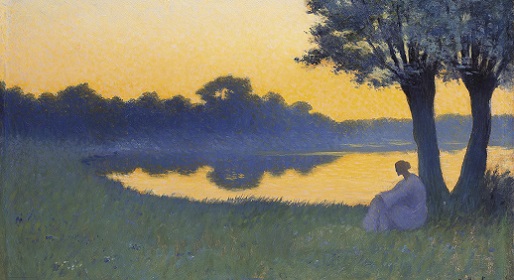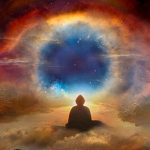by John Roger Barrie: The eloquence of the deepest silence echoes from the eternal…

Originating there and reverberating through the ripples of time and space, it bursts forth in shimmering waves, forming light and color, shadow, and dimension. But it remains unchanged. Never affected by the slightest permutation of outer phenomenon, silence interweaves the temporal but is forever untouched by it.
Ever abiding within and without, overlaid with the mutable patchwork garment we know as this visible universe, silence forms the woof and warp of all things seen and unseen. Yet at any instant it is immanent and accessible. To the mystic, silence is the ground, the core of reality. All else relates to and emanates from it.
The deeper elements in all religions point to this silence. It is God, it is Buddha; it is Allah. But, to paraphrase Lao Tzu,1to name it is to elude its essence. It can only be experienced. The fifteenth century Muslim born saint Kabir wittily observed, “I laugh when I hear the fish in the water is thirsty.”2 This paradox, which asserts that we are forever surrounded by silence yet all the while occluded to its existence, forms the key dilemma in spirituality.
How can we not experience that which always envelops and permeates us? Merely affirming its existence will not garner for us its experiential realization. It is spiritual practice that provides us with the means to fine tune our faculties so that we perceive it for ourselves. Such practice enables us, in due course, to experience a blistering, conscious realization of silence that suffuses the core of our being.
By embarking on the spiritual path, an aspirant is attempting to encounter silence firsthand. This is the quintessential journey in life—the inner sojourn. It is returning to a source long ago forgotten but often glimpsed at moment unawares. Recapturing that which flitters on the periphery of awareness is the goal of the mystic. Firmly abiding in the thundering silence that invisibly drenches us is the teleological aim of life according to philosopher Gerald Heard (1889-1971).3 The mystic consciously dives into silence, at first unfelt. With repeated practice it becomes a living, palpable Presence filled with immeasurable vitality and boundless, nondual continuity. But what causes this gradual revelation?
First we need to discover why we do not experience silence. The simplest answer is that we are habituated to noise. We are addicted to novelty, sensation, to ourselves. Fuss and commotion, mental chattering, and outer stimulation occupy our minds from dawn to dusk. The twentieth-century Japanese Zen master Nan-in rightly noted that we are overflowing with our own ideas and opinions; to learn Zen we must first empty our minds. But there is no room for such emptiness. When one is clattering away on a keyboard sixteen hours every day, the capacious pockets of silence are kept well at bay. We thereby deafen ourselves to the underlying silence we would otherwise clearly hear.
By intentionally quieting our restless minds and calling a temporary halt to the random noise—inner and outer—to which we are subject, we create an environment conducive to the manifestations of silence. Welling up from within, this silence subtly engulfs us, drowning out all the noise of existence. The Jewish mystics refer to God as ayin, nothingness. When we quell the somethingness of our lives, this nothingness emerges. But as long as we dwell in the realm of substance, it remains elusive.
When constantly engaged at the forefront of our minds, our awareness restlessly flutters about from thought to thought, sensation to sensation, thus pushing out silence. The effort—tapas—required to break through the surface waves of the mind forges an inward path to the deeper levels of silence. When deliberately sustained via committed, ongoing spiritual practice, this inner drilling displaces the obfuscatory debris that clutters the mind with a matrix of noise. When all mental ruminations are at last exhausted, genuine silence emerges.
There are many different means to contact this silence. The devotee stirs up, then propels affective emotions toward it, transcending the self en route. The intellectual discerns silence from noise, then expels the latter from his mental field. The contemplative eradicates thought and invites silence to fill the ensuing gap. The active infuse their actions with a selfless intent that serendipitously chisels through the boundaries of the ego. All four eventually lose themselves in a borderless existence. All effectively dispatch wandering thoughts and narcissistic mentations into a cauldron of deep tranquility, which is the fruit of ripening silence. As the Chinese sage further counsels, “Become empty of yourself and realize inner silence.”5
But many prefer the comfort of noise, the bustling crowds, the constant engagement of new thoughts and interesting repartee. To embrace silence means splicing off a certain arena of the familiar and venturing into heretofore uncharted territories. While one may fruitfully participate in communal spiritual activities, quite often the deeper stages of this voyage are undertaken by oneself. It is, as Plotinus maintains, “The flight of the alone to the Alone.”6 To keep the mind occupied with external concerns is to point the inner compass in an outward direction. This is the most subtle trap to which the feeble mind continually succumbs. For to interact constantly with the objects of the senses is to eclipse entirely the realm of silence, which is first experienced within. When repeatedly accessed, the decibel level of true silence will deafen the resolute mystic.
Ever elusive yet all pervading, silence is known by those who take the leap. The adventuresome hiker seeks areas untrampled by the masses. The successful inner voyager treks to the precipice, and then, having encountered the Unknowable, brazenly discards map and compass and boldly treads onward. The yearning heart echoes the cry that seized the Psalmist: “Be still and know that I am God.”7 The knowing mystic, seized with a searing nondual vision, confidently answers back, “Be silent and know that you, too, are God.”
















































